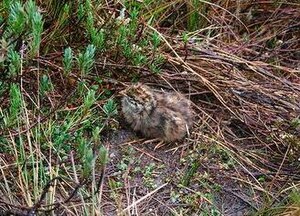Snow mountain quail
| Snow mountain quail | ||||||||
|---|---|---|---|---|---|---|---|---|

Snow Mountain Quail ( Anurophasis monorthonyx ) |
||||||||
| Systematics | ||||||||
|
||||||||
| Scientific name of the genus | ||||||||
| Anurophasis | ||||||||
| van Oort , 1910 | ||||||||
| Scientific name of the species | ||||||||
| Anurophasis monorthonyx | ||||||||
| van Oort , 1910 |
The snow mountain quail ( Anurophasis monorthonys ) is a species of the pheasant family . It is the only representative of the genus Anurophasis and occurs exclusively in Southeast Asia. Similar to the black quail, the snow mountain quail is one of the least researched chicken birds. The species is considered endangered.
Appearance
The snow mountain quail reaches a body length of 25 to 28 centimeters and weighs around 401 grams. In the male, the basic color of the plumage is a reddish chestnut brown. There are no markings on the sides of the head, the throat or the underside of the body. The ear patches, the chest and the flanks, however, have wide black horizontal stripes. The female, on the other hand, is significantly lighter. The horizontal stripes in the plumage are slightly less pronounced than in the male. Young birds have more irregular and often openwork horizontal stripes.
Distribution area and habitat
The species occurs exclusively in the snow-capped mountains of New Guinea and Java. Among other things, the Carstensz pyramid and the Wilhelminagebirge are settled . The habitat are alpine mats on northern slopes and plateaus at altitudes between 3100 and 4200 meters.
Way of life
Almost nothing is known about the way of life of the snow mountain quail. So far it has mainly been observed singly or in pairs. Only in exceptional cases were more than three mountain quails seen together. So far, only one nest containing three eggs has been found. The diet consists of grass seeds, leaves, flowers, caterpillars and other invertebrates.
supporting documents
literature
- Steve Madge , Phil McGowan, and Guy M. Kirwan : Pheasants, Partridges and Grouse. A Guide to the Pheasants, Partridges, Quails, Grouse, Guineafowl, Buttonquails and Sandgrouse of the world. Christopher Helm, London 2002, ISBN 0-7136-3966-0 .